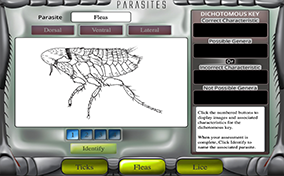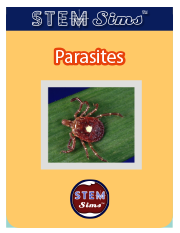What is a parasite?
A parasite is is an organism that lives on or in another organism, known as the host. The parasite benefits from its host, but the host suffers from the parasite.
What are lice?
Lice are wingless, parasitic insects that live on warm-blooded hosts. Since lice are insects, an adult louse typically has three body sections and six legs. These parasites live on the external parts of their hosts. Lice can live on almost all birds and mammals. One of the major diseases transmitted by lice is typhus. The bacteria causing typhus is spread by lice excrement. Typhus has killed hundreds of thousands of people over the course of human history.
What are some common genera of lice?
Haematopinus – These lice are found on many important domesticated animals, including cattle, horse, swine, and donkeys. They are also found on antelope, water buffalo, camels, zebra, and deer.
Pediculus – These sucking lice are most often associated with humans and include head lice and body lice. Typhus can be transmitted via the bite of a head or body louse.
Pthirus – These lice are called pubic lice (or crab lice) since they occupy the pubic area of human adults and are rarely found on pre-pubescent children. Although irritating, these lice rarely transmit any diseases through their bite.
Solenopotes – These lice are found on cattle and are also called little blue cattle lice.
Linognathus – These lice are found on dogs, sheep, deer, and cattle. Heavy infestations of the lice have been reported to have caused death to calves.
Hoplopleura – These lice are also called common rat lice and are typically found in tropical Asia and Africa.
What are ticks?
Ticks are parasites in the taxonomic class called Arachnida. This class includes spiders and mites. Ticks have lost body segmentation and only have two main body sections. Adult ticks typically have eight legs. Rocky Mountain spotted fever, Colorado tick fever, and Lyme disease are just a few of the human infections transmitted by tick bites. Two new tick-borne diseases arose in 2017: Borrelia miyamotoi and Bourbon virus. The number of tick-related diseases has doubled in the past decade and a half.
What are some common genera of ticks?
Argas – This parasite is a soft-bodied tick often found on common bird livestock, such as chicken, geese, and ducks.
Antricola – These ticks have a soft body and are found on cave-dwelling bats.
Ixodes – These genera of tick are one of the most common and problematic for humans. These hard-bodied ticks, like the deer tick, are important vectors for disease transmission, such as Lyme disease.
Amblyomma – These hard-bodied ticks are very common in North and South America and transmission vectors of Rocky Mountain spotted fever.
Haemaphysalis – Often called the rabbit tick or grouse tick, these hard-bodied ticks are one of the most widely distributed in the world.
Ornithodoros – The “ornith” part of their name gives away on which organism these ticks are commonly found: birds. There are around 126 different known species of these soft-bodied ticks.
What are fleas?
Fleas are non-flying, parasitic insects that have the ability to jump around 50 times their own body length. They feed on the blood of mammals and birds. A number of diseases are transmitted by fleas, including the Bubonic plague, which killed nearly 20 million people. Fleas can transmit viruses, bacteria, and/or protozoans to the host organism as they feed on the host’s blood.
What are some common genera of fleas?
Ctenocephalides canis – This flea, commonly called the dog flea, is very similar to the cat flea. The flea can also be found on chipmunks, opossums, raccoons, and in the absence of a dog, can bite humans.
Ctenocephalides felis – Commonly called the cat flea, this flea lives on domestic cats and a host of other mammals.
Leptopsylla – These fleas include ones commonly called the European mouse flea or simply the mouse flea.
Cediopsylla – This flea is commonly called the rabbit flea.
Diamanus – This flea is commonly called the ground squirrel flea.
Echidnophaga – This flea is commonly called the hen flea.
Nosopsyllus – This flea is commonly called the northern rat flea.
Pulex – This flea is commonly called the human flea.
Xenopsylla – This flea is commonly called the Oriental rat flea and is the flea associated with spreading Bubonic plague.
 What is about the size of a pinhead, but is powerful enough to have killed tens of millions of people over the course of human history? If you answered tick, lice, and fleas, you would be correct. These blood-sucking parasites often transmit viruses and bacteria to people in their quest for human blood. Do you have an itch to begin your investigation of some common human parasites? Get scratching.
What is about the size of a pinhead, but is powerful enough to have killed tens of millions of people over the course of human history? If you answered tick, lice, and fleas, you would be correct. These blood-sucking parasites often transmit viruses and bacteria to people in their quest for human blood. Do you have an itch to begin your investigation of some common human parasites? Get scratching.

